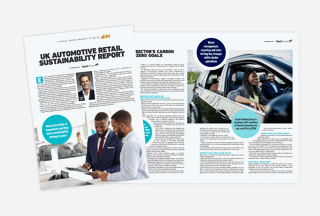Rupert Pontin, commercial director at One Auto API, takes a closer look at how risks right across the sector are ready and waiting to chip away at confidence, efficiency and, ultimately, profits.
Although used car values are considerably higher than they were three years ago, a gradual improvement in new car supply, and a slight reduction in used car demand, has been behind a return to a more traditional pattern of deflation in used car values in recent months.
At the same time, current economic headwinds are beginning to have a negative effect on consumer demand.
While inflation may be dropping, the Bank of England base rate continues to rise and increasing numbers of homeowners are facing huge rises in payments as their fixed rates come to an end. As a result, many car buyers are thinking long and hard about what their finances look like and what they can afford.
For a used car retailer this is beginning to have a tangible day-to-day impact in terms of reduced footfall in showrooms and lower enquiry volumes. There is also the possibility it will place additional strain on the supply of used car stock as customers choose to hold onto cars for longer than they may have originally intended.
In light of supply chain turbulence and economic strain, success in used car retailing can only be built on a clear appreciation of risk at every stage of the process. Identifying the right stock that will return the required margin is key, and using multiple data sources and embracing wider market insight will make that task much easier.
Sourcing vehicles
Finding good used car stock has been a significant issue over the past couple of years, and there is little chance of a marked increase in the availability of used cars in the near future due to the lower volumes of new car sales.
Auction houses remain popular but the emergence of more car buying sites in the last twelve months has meant consumers have more options for selling their car before they head to the retailers to buy a new or replacement vehicle. This has reduced the number of part exchanges going to auction and meant that wholesale used car buyers have had to work harder to find the cars they need to fill forecourts.
Wherever you choose to look, every potential vehicle source in the sector will still have the full spectrum of both delightful and dreadful cars on offer. It is only by taking advantage of every piece of information available, that wholesale buyers can be sure that the golden egg they spot is everything it’s cracked up to be.
Consideration needs to be given to a multitude of vehicle pitfalls such as outstanding recalls, previous use as a taxi, purchase via a salvage sale or hidden details in their history that can only be revealed using a thorough provenance check.
All of these issues can turn that golden egg into a rotten tomato and some will inevitably lead to additional preparation time, increased stocking costs and lower margins.
Similarly, advertising history can be a valuable indicator of a problem car. If a vehicle has been made available for retail or trade sale multiple times from different sources in the past 12 months, then it is an indication that it is difficult to sell – and can be a sign that something isn’t quite right.
As a wholesale used car buyer, this heightened level of insight puts you at a real advantage. An incomplete picture of the car in question can result in hesitancy about the best way forward. Alternatively, if armed with the full facts, used car buyers will be in a much better position to decide whether to pay more money for a car that is a really good retail opportunity.
Beware the Wild West
Such vigilance is absolutely essential if the need to find alternative sources of used car stock, forces buyers to deal direct with private sellers.
In this scenario there are likely to be a number of falsely described cars hiding problems that may have already been found by other businesses using comprehensive data checks.
If a car has been refused as a part exchange, or turned down by a car buying service, the seller has no choice but to sell via a private advert. With the number of these cars on offer on the increase, it is prudent to remember that if something looks too good to be true, then it probably is.
Turning stock into profit
In a vibrant market, prices are also changing faster than ever. So, there is a strong argument to consider daily pricing, as failing to react to changing market conditions could mean missing out on enhanced potential returns.
By keeping a close eye on live retail adverts and trade pricing guides retailers be sure that their pricing is fine tuned for maximum profit.
This is particularly relevant for electric vehicles. As more hybrid and Battery Electric Vehicles (BEVs) enter the used market, and demand fluctuates, retailers need to be on top of pricing variations and this has not been easy of late.
Although pricing of these models has started to stabilise, there is still a high level of reluctance from some retailers to buy them for used car stock. This is partly still linked to concerns about prices falling further, but also due to a lack of experience and knowledge about how to prepare and then present them for sale as well as subsequently convert customers effectively.
This ‘unknown’ factor can creep into a more conventional used car stock mix too as, while the engine may be familiar, the age of the vehicle may not. Many used car retailers are having to buy stock with an age and mileage profile they are less familiar with and dealing with higher mileage stock picked up from new sources can bring its own challenges.
Getting the deal right
It’s not only successful used car retailers that will be keeping an eye on risk.
Finance providers can certainly take confidence from the fact that the used car market typically shows resilience in a downturn and, while supply is improving, there is still a shortage of used cars so values should hold strong. However, as customer finances are stretched to the limit, there is increasing potential for default so lenders will be looking closer than ever at the mix of cars they have on risk and the deal parameters they allow for.
Without this level of scrutiny, it’s more difficult to minimise risk exposure which, in turn, will lead to losses in the event of repossession.
Using all of the tools at your disposal
Whatever your position in the used car market, there has never been more key data available to assist with decision making.
As a result, while the challenge to turn a profit may seem increasingly daunting, it has never been easier to take a more rounded and detailed view of risk at every stage of the process – giving you the best chance of reducing costs and boosting your bottom line.
As the saying goes, ‘knowledge is power’.




















Login to comment
Comments
No comments have been made yet.